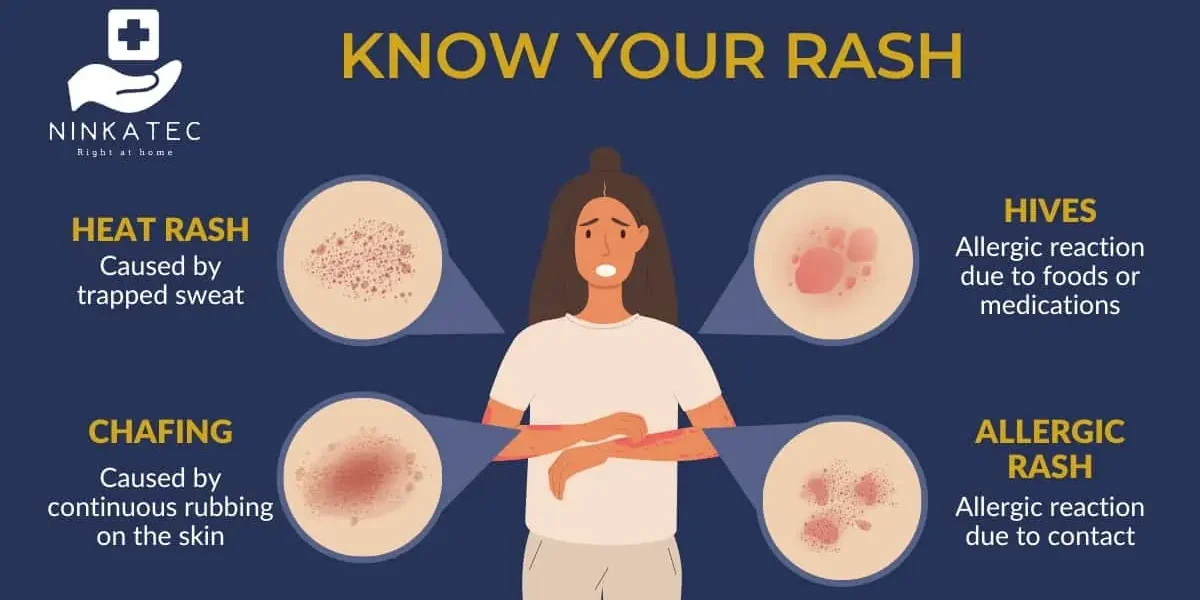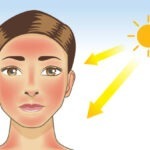Rashes are common skin problems that can affect anyone. They can be caused by various factors, such as allergies, infections, irritants, or diseases. Rashes can appear as red, itchy, scaly, bumpy, or blistered patches on the skin. They can affect a small area or the whole body. Some rashes are minor and harmless, while others are severe and need medical treatment.
What are the causes of rashes?
There are many possible causes of rashes, depending on the type and location of the rash. Some of the most common causes are:
• Allergens: These are substances that trigger an allergic reaction in the body. Examples of allergens include pollen, dust mites, animal dander, latex, cosmetics, perfumes, food, drugs, and insect stings. Allergic rashes can appear as hives (raised, red welts), contact dermatitis (redness and itching at the site of contact), or eczema (dry, scaly patches).
• Infections: These are caused by bacteria, viruses, fungi, or parasites that invade the skin. Examples of infections that can cause rashes include impetigo (honey-colored crusts), ringworm (circular scaly patches), chickenpox (red blisters), measles (red spots), and molluscum contagiosum (pearly bumps). Infections can also cause fever, pain, swelling, or pus.
• Irritants: These are substances that irritate or damage the skin. Examples of irritants include soap, detergent, bleach, chemicals, plants (such as poison ivy), and friction. Irritant rashes can appear as redness, burning, itching, or dryness.
• Diseases: These are conditions that affect the immune system or other organs of the body. Examples of diseases that can cause rashes include psoriasis (thick, scaly patches), lupus (butterfly-shaped rash on the face), rosacea (facial flushing and redness), granuloma annulare (ring-shaped bumps), lichen planus (purple or gray bumps), and pityriasis rosea (pink oval patches).
What are the symptoms of rashes?
The symptoms of rashes vary depending on the type and cause of the rash. Some of the common symptoms are:
• Color: Rashes can be red, pink, purple, gray, white, brown, yellowish-brown or black. The color may change over time or with exposure to heat or cold.
• Shape: Rashes can be round, oval, linear, irregular or geometric. They can also have different patterns such as lacy or blotchy.
• Size: Rashes can be small or large. They can affect a single spot or cover a large area of the body.
• Texture: Rashes can be smooth or rough. They can also have different features such as scales (flakes), crusts (scabs), blisters (fluid-filled bumps), pustules (pus-filled bumps), papules (solid bumps), nodules (hard lumps) or ulcers (open sores).
• Sensation: Rashes can be itchy or not. They can also cause pain, burning, stinging or tingling sensations.
How are rashes diagnosed?
To diagnose a rash, a doctor will usually ask about your medical history and examine your skin. The doctor may also ask about your exposure to any potential allergens or irritants. In some cases,
the doctor may perform some tests to confirm the diagnosis or rule out other conditions. These tests may include:
• Skin scraping: A tiny sample of skin cells from the afflicted area is taken and examined under a microscope for symptoms of infection or inflammation.
• Skin biopsy: This involves removing a small piece of skin tissue from the affected area and sending it to a laboratory for analysis.
• Blood test: This involves drawing a sample of blood from your vein and checking it for signs of infection or disease.
• Allergy test: This involves applying a small amount of an allergen to your skin and observing for any reaction.
How are rashes treated?
The treatment of rashes depends on the type and cause of the rash. Some of the common treatments are:
• Medications: These include creams, ointments, lotions or pills that can help reduce inflammation,
itching or infection. Examples of medications include corticosteroids (anti-inflammatory drugs), antihistamines (anti-allergy drugs), antibiotics (anti-bacterial drugs), antifungals (anti-fungal drugs) and antivirals (anti-viral drugs).
• Phototherapy: This involves exposing your skin to ultraviolet light to help reduce inflammation or improve your skin condition. Phototherapy is often used for psoriasis and eczema.
• Laser therapy: This involves using a laser beam to remove abnormal skin cells or blood vessels that cause your rash. Laser therapy is often used for rosacea and port-wine stains.
• Surgery: This involves cutting out or destroying abnormal skin tissue that causes your rash. Surgery is often used for skin cancers and warts.
How can you prevent rashes?
To prevent rashes from occurring or worsening you should:
• Avoid triggers: Try to identify and avoid any substances that cause you to have an allergic reaction or irritate your skin. These may include certain foods, drugs, cosmetics, jewelry, plants, insects, or fabrics.
• Protect your skin: Use gentle soaps, moisturizers, and sunscreens to keep your skin clean, hydrated, and protected from sun damage. Wear appropriate clothing and gloves to shield your skin from harsh weather or chemicals.
• Maintain good hygiene: Wash your hands frequently and keep your nails short to prevent spreading germs or scratching your skin. Change your bedding and towels regularly and avoid sharing personal items such as razors or brushes to prevent infection.
• Manage stress: Stress can worsen some skin conditions such as eczema or psoriasis. Try to find healthy ways to cope with stress such as meditation, exercise, or hobbies.
How can you manage rashes at home?
To manage rashes at home you should:
• Apply cold compresses: This can help reduce swelling, redness, and itching. Wrap some ice cubes or a bag of frozen peas in a cloth and apply it to the affected area for 10 to 15 minutes several times a day.
• Use oatmeal baths: This can help soothe irritated or inflamed skin.Add one cup of finely ground oatmeal to a tub of warm water and soak for 15 to 20 minutes once a day. You can also use oatmeal-based products such as lotions or creams.
• Use baking soda paste: This can help dry out blisters or pustules. Mix three parts baking soda with one part water and apply it to the affected area for 10 minutes once a day. Rinse off with cool water afterwards.
• Use aloe vera gel: This can help heal wounds or burns. Cut open an aloe vera leaf and squeeze out the gel inside. Apply it to the afflicted region many times each day.
Conclusion
Rashes are common skin problems that can have various causes, symptoms, and treatments. They can range from mild to severe and affect different parts of the body. If you have a rash that does not improve with home remedies, causes you discomfort, or is accompanied by other symptoms such as fever, pain, or difficulty breathing, you should see a doctor as soon as possible.



